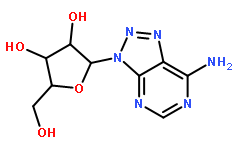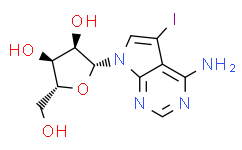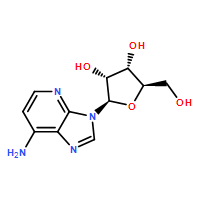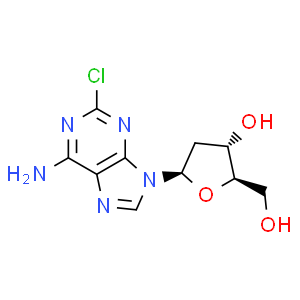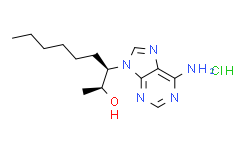| 中文名称: | ABT-702 dihydrochloride | ||||
|---|---|---|---|---|---|
| 英文名称: | ABT-702 dihydrochloride | ||||
| 别名: | ABT702 二盐酸盐 5-(3-bromophenyl)-7-(6-morpholinopyridin-3-yl)pyrido[2,3-d]pyrimidin-4-amine dihydrochloride | ||||
| CAS No: | 1188890-28-9 | 分子式: | C22H21BrCl2N6O | 分子量: | 536.25 |
| CAS No: | 1188890-28-9 | ||||
| 分子式: | C22H21BrCl2N6O | ||||
| 分子量: | 536.25 | ||||
基本信息
|
产品编号: |
A12406 |
||||
|
产品名称: |
ABT-702 dihydrochloride |
||||
|
CAS: |
1188890-28-9 |
储存条件 |
粉末 |
-20℃ |
四年 |
|
|
|
||||
|
分子式: |
溶于液体 |
-80℃ |
两年 |
||
|
分子量 |
536.25 |
-20℃ |
一个月 |
||
|
化学名: |
5-(3-bromophenyl)-7-(6-morpholinopyridin-3-yl)pyrido[2,3-d]pyrimidin-4-amine dihydrochloride |
||||
|
Solubility (25°C): |
|||||
|
体外:
|
DMSO |
100mg/mL (186.48mM) |
|||
|
Ethanol |
3mg/mL (5.59mM) |
||||
|
Water |
Insoluble |
||||
|
体内(现配现用): |
1.请依序添加每种溶剂:10% DMSO→40% PEG300→5% Tween-80→45% saline Solubility: ≥ 2.5mg/mL (4.66mM); Clear solution |
||||
|
此⽅案可获得 ≥ 2.5mg/mL (4.66mM,饱和度未知) 的澄清溶液。 以 1mL ⼯作液为例,取 100μL 25.0mg/mL 的澄清 DMSO 储备液加到 400μL PEG300 中,混合均匀;向上述体系中加⼊ 50μL Tween-80,混合均匀;然后继续加⼊ 450μL ⽣理盐⽔定容⾄ 1mL。 |
|||||
|
2.请依序添加每种溶剂:10% DMSO→90% (20% SBE-β-CD in saline) Solubility: ≥ 2.5mg/mL (4.66mM); Clear solution |
|||||
|
此⽅案可获得 ≥ 2.5mg/mL (4.66mM,饱和度未知) 的澄清溶液。 以 1mL ⼯作液为例,取 100μL 25.0mg/mL 的澄清 DMSO 储备液加到 900μL 20% 的 SBE-β-CD ⽣理盐⽔⽔溶液中,混合均匀。 |
|||||
|
3.请依序添加每种溶剂:10% DMSO→90% corn oil Solubility: ≥ 2.5mg/mL (4.66mM); Clear solution |
|||||
|
此⽅案可获得 ≥ 2.5mg/mL (4.66mM,饱和度未知) 的澄清溶液,此⽅案不适⽤于实验周期在半个⽉以上的实验。 以 1mL ⼯作液为例,取 100μL 25.0mg/mL 的澄清 DMSO 储备液加到 900μL ⽟⽶油中,混合均匀。 |
|||||
|
<1mg/ml表示微溶或不溶。 |
|||||
|
普西唐提供的所有化合物浓度为内部测试所得,实际溶液度可能与公布值有所偏差,属于正常的批间细微差异现象。 |
|||||
|
请根据产品在不同溶剂中的溶解度选择合适的溶剂配制储备液;⼀旦配成溶液,请分装保存,避免反复冻融造成的产品失效。 |
|||||
制备储备液
|
浓度
溶液体积 质量 |
1mg |
5mg |
10mg |
|
1mM |
1.8648mL |
9.3240mL |
18.6480mL |
|
5mM |
0.3730mL |
1.8648mL |
3.7296mL |
|
10mM |
0.1865mL |
0.9324mL |
1.8648mL |
|
50mM |
0.0373mL |
0.1865mL |
0.3730mL |
生物活性
|
产品描述 |
一种有效的腺苷激酶 (AK) 抑制剂 (IC50=1.7nM)。 |
|
靶点 |
adenosine kinase 1.7nM |
|
体外研究 |
ABT-702 is an orally effective adenosine kinase inhibitor that has several orders of magnitude selectivity over other sites of adenosine (ADO) interaction (A1, A2A, A3 receptors, ADO transporter, and ADO deaminase). ABT-702 is equipotent (IC50 =1.5±0.3nM) in inhibiting native human AK (placenta), two human recombinant isoforms (AKlong and AKshort), and AK from monkey, dog, rat, and mouse brain. ABT-702 potently inhibits the activity of rat brain cytosolic AK in a concentrationdependent manner with an IC50 value of 1.7nM. ABT-702 also potently inhibits AK activity in intact cultured IMR-32 human neuroblastoma cells (IC50=51nM), indicating that ABT-702 can penetrate the cell membrane and potently inhibit AK at its intracellular site |
|
体内研究 |
ABT-702 significantly reduces acute thermal nociception in a dose-dependent manner after both intraperitoneal (ED50=8 μ mol/kg i.p.) and oral (ED50=65 μmol/kg p.o.) administration in the mouse hot-plate test. Consistent with its antinociceptive effects in the hot-plate assay, ABT-702 also produces dose-dependent antinociceptive effects (ED50=2 μmol/kg i.p.) in the abdominal constriction assay. Like Morphine (21 μmol/kg i.p.), ABT-702 exhibits full efficacy in this model of persistent chemical pain. Rats are given an intraperitoneal injection of the adenosine A1 receptor antagonist DPCPX (3mg/kg), ABT702 (3mg/kg), or vehicle 10 minutes prior to an intravenous injection of 2-18F-fluorodeoxy-D-glucose (FDG) (FDG, 15.4±0.7 MBq per rat). Rats are then subjected to a 15 minute static positron emission tomography (PET) scan. Reconstructed images are normalized to FDG PET template for rats and standard uptake values (SUVs) are calculated. To examine the regional effect of active treatment compared to vehicle, statistical parametric mapping analysis is performed. Whole-brain FDG uptake is not affected by drug treatment. Significant regional hypometabolism is detected, particularly in cerebellum, of DPCPX and ABT-702 treated rats, relative to vehicle-treated rats. Thus, endogenous adenosine can affect FDG accumulation although this effect is modest in quiescent rats. Body weight (316.8±28.4 g; mean±SD) and blood glucose (5.5±1.7mM) are not significantly different among three groups. Whole-brain PET SUV values are 1.6±0.4, 1.6±0.6, and 1.8±0.6 for vehicle, ABT702, and DPCPX-treated rats, respectively (F(2,9)=0.298, P=0.75). statistical parametric mapping (SPM) analysis reveals significant regional hypometabolism in the cerebellum, mesencephalic region, and medulla in the ABT-702-treated rats compared to the vehicle-treated rats |
推荐实验方法(仅供参考)
|
Animal Administration |
Rats Rats are fasted for 16 hours prior to use. At the beginning of the experiment, each rat is weighed, and then anesthetized using 5% isoflurane for induction and 2.5% for maintenance. A blood sample from tail vein is collected for a fasting blood glucose determination using a standard glucometer. Rats are then given an intraperitoneal (i.p.) injection of DPCPX (3mg/kg, n=4), ABT-702 (3mg/kg, n=4), or an equivalent volume of vehicle (15% dimethyl sulfoxide, 15% cremophor EL, 70% saline, n=4) to manipulate the effect of endogenous adenosine on neuronal activities. Ten minutes after i.p. injection, rats are administered FDG (15.4±0.7 MBq) in 0.3-0.5mL saline by intravenous (i.v.) tail vein injection. Rats are allowed to recover from anesthesia after the FDG injection but are reanesthetized for 15-minute-static PET scan with the head in the center of the field of view. All images are reconstructed |
本计算器可帮助您计算出特定溶液中溶质的质量、溶液浓度和体积之间的关系,公式为:
质量 (g) = 浓度 (mol/L) x 体积 (L) x 分子量 (g/mol)
摩尔浓度计算公式
用本工具协助配置特定浓度的溶液,使用的计算公式为:
开始浓度 x 开始体积 = 最终浓度 x 最终体积
稀释公式
稀释公式一般简略地表示为:C1V1 = C2V2 ( 输入 输出 )



